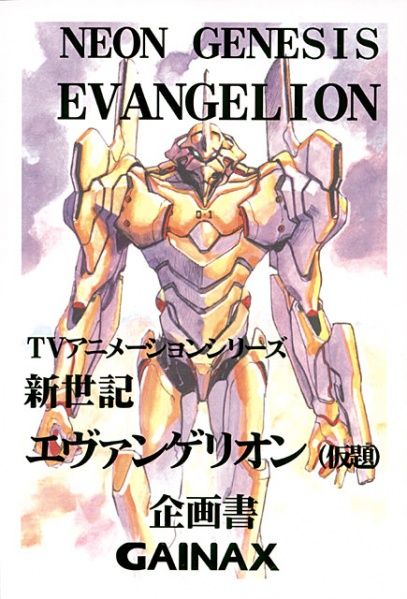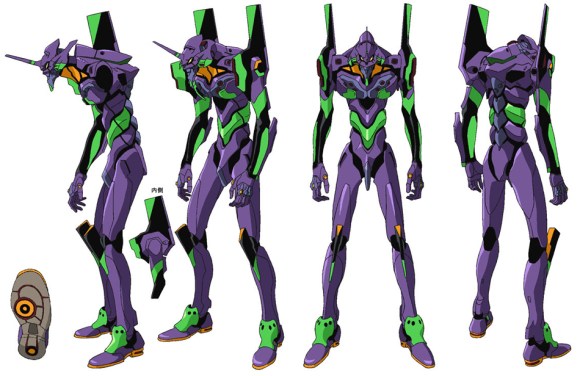
The anime/merchandising franchise Evangelion is one of the few animated series, like One Piece or Gundam, to have achieved true cultural mainstream status in Japan. Even people who have never watched an episode of the TV series (or seen an installment of the movie, or read a chapter of the comic, or played one of the pachinko machine adaptations, or shaved with one of the Eva razors, or eaten one of the Eva burgers… like we said, franchise) can recognize its iconic characters and giant robots.
It wasn’t always like that, though. When Evangelion (or simply Eva, as its fans call it) began airing in 1995, its robot designs took some getting used to. Whereas most anime robots were inspired by a body builder’s physique, Eva’s machines had an almost gangly appearance, with lanky limbs, stooped posture, and what appeared to be tennis shoes. Their fragile look would turn out to be a perfect match for the psyches of their teenaged pilots, but things didn’t start out that way, as shown in Eva’s early planning portfolio.
▼ The final Evangelion design
The initial design kept much more in line with tradition, with broad shoulders and a helmeted look evocative of an NFL running back in full pads. The coloring is also much simpler and brighter, with an overall more kid-friendly feel that prompted one Japanese Internet user to comment, “Looks more like a Power Ranger.”
Concept sketches for protagonist Shinji’s robot are even more heroic, with six-pack abs and swooping shoulder extensions making it look like an angelic knight in shining armor.
It’s also shown wielding a gigantic samurai sword, as opposed to the much more sensibly sized combat knife it carries in the franchise now.
Speaking of Eva’s main character, Shinji’s physical design didn’t change much, although seeing him smiling mischievously is a bit of a shock, given how he spends most of the series dealing with crippling levels of depression and emotional isolation. The accompanying notes describe him as a “quiet” honor student who “develops as a person by experiencing various events,” which, while still accurate in the series’ final form, is a pretty impressive case of understatement.
There’s no mistaking fellow pilots Asuka and Rei, despite Asuka’s hair being shorter and Rei’s a far less dazzling shade of blue than in their TV incarnations.
▼ Final Asuka and Rei designs
Tactician Misato and scientist Ritsuko’s ‘80s inspired clothing didn’t quite make the final cut, nor did Ritsuko’s love of bonsai and punk rock, as stated in the production notes.
The document also makes reference to 27 Angels–the extraterrestrial creatures Eva’s heroes fight against–as opposed to the 17 which appear in the anime.
But by far the most shocking divergence from what Evangelion eventually became lies tucked away in the initial story synopsis, with a tinny little blurb for its 26th and final TV episode that promises, “All mysteries and drama are resolved.”
Sixteen years and five theatrical versions later, Eva still hasn’t come to a decisive conclusion. Not that its masses of fans are complaining. It’s true that each new installment of the franchise leaves viewers scratching their heads, but that’s OK when it also but leaves them on the edge of their seats.
Source: Livedoor
Top image: Livedoor
Insert images: Cosplay Island, Livedoor, Anime Dump













 Fourth and final Evangelion Rebuild movie finally has release date, beautiful new trailer【Video】
Fourth and final Evangelion Rebuild movie finally has release date, beautiful new trailer【Video】 Evangelion? Cool. Katana? Cool. Evangelion and katana? Very cool!
Evangelion? Cool. Katana? Cool. Evangelion and katana? Very cool! Evangelion chocolates: The Valentine’s Day gift with serious visual impact
Evangelion chocolates: The Valentine’s Day gift with serious visual impact Evangelion lingerie is sure to help your otaku partner get into Beast Mode
Evangelion lingerie is sure to help your otaku partner get into Beast Mode Evangelion loafers – Never worry about tying your shoes or failing to make an impression
Evangelion loafers – Never worry about tying your shoes or failing to make an impression Disillusionment at Tsukiji’s tourist-target prices led us to a great ramen restaurant in Tokyo
Disillusionment at Tsukiji’s tourist-target prices led us to a great ramen restaurant in Tokyo Starbucks Japan releases new zodiac chilled cup drink for 2026
Starbucks Japan releases new zodiac chilled cup drink for 2026 A Japanese dating app matched our bachelorette with a Buddhist monk, and she learned some things
A Japanese dating app matched our bachelorette with a Buddhist monk, and she learned some things Large amount of supposed human organs left in Osaka marketplace
Large amount of supposed human organs left in Osaka marketplace We taste makunouchi bento at four Japanese convenience store chains【Taste comparison】
We taste makunouchi bento at four Japanese convenience store chains【Taste comparison】 Japan’s last two pandas leaving for China next month, Ueno Zoo announces final day for twins
Japan’s last two pandas leaving for China next month, Ueno Zoo announces final day for twins Moon prism comparison! Video places new, old Sailor Moon transformations side-by-side
Moon prism comparison! Video places new, old Sailor Moon transformations side-by-side Elephant nose ice cream: The treat with a trunk
Elephant nose ice cream: The treat with a trunk Starbucks Japan serves surprise fall Frappuccino with rare appearance by Western pear【Taste test】
Starbucks Japan serves surprise fall Frappuccino with rare appearance by Western pear【Taste test】 7-Eleven Japan starts new temporary luggage storage service in over 300 branches
7-Eleven Japan starts new temporary luggage storage service in over 300 branches Starbucks teams up with 166-year-old Kyoto doll maker for Year of the Horse decorations【Photos】
Starbucks teams up with 166-year-old Kyoto doll maker for Year of the Horse decorations【Photos】 Tokyo’s Tsukiji sushi neighborhood asks tour groups to stay away for the rest of the month
Tokyo’s Tsukiji sushi neighborhood asks tour groups to stay away for the rest of the month Street Fighter Hadouken Churros to be launched and eaten in Tokyo, Okami pudding on offer too
Street Fighter Hadouken Churros to be launched and eaten in Tokyo, Okami pudding on offer too Japanese avoiding domestic travel as foreign tourists increase, possibly creating vicious cycle
Japanese avoiding domestic travel as foreign tourists increase, possibly creating vicious cycle Japanese woman mistaken for bear
Japanese woman mistaken for bear Return of Totoro sequel short anime announced for Ghibli Park
Return of Totoro sequel short anime announced for Ghibli Park Is this the most relaxing Starbucks in Japan?
Is this the most relaxing Starbucks in Japan? Starbucks on a Shinkansen bullet train platform: 6 tips for using the automated store in Japan
Starbucks on a Shinkansen bullet train platform: 6 tips for using the automated store in Japan More Shinkansen trains being added to Japan’s “golden route” to meet traveler demand
More Shinkansen trains being added to Japan’s “golden route” to meet traveler demand Japan’s human washing machines will go on sale to general public, demos to be held in Tokyo
Japan’s human washing machines will go on sale to general public, demos to be held in Tokyo Starbucks Japan unveils new Christmas goods and a rhinestone tumbler that costs 19,500 yen
Starbucks Japan unveils new Christmas goods and a rhinestone tumbler that costs 19,500 yen Japanese train company is letting fans buy its actual ticket gates for their homes
Japanese train company is letting fans buy its actual ticket gates for their homes Is China’s don’t-go-to-Japan warning affecting tourist crowds in Tokyo’s Asakusa neighborhood?
Is China’s don’t-go-to-Japan warning affecting tourist crowds in Tokyo’s Asakusa neighborhood? The 10 best day trips from downtown Tokyo【Survey】
The 10 best day trips from downtown Tokyo【Survey】 Tokyo considering law requiring more trash cans following litter increase in heavily touristed area
Tokyo considering law requiring more trash cans following litter increase in heavily touristed area Nintendo’s Kirby now delivering orders at Kura Sushi restaurants, but not in Japan
Nintendo’s Kirby now delivering orders at Kura Sushi restaurants, but not in Japan Survey asks foreign tourists what bothered them in Japan, more than half gave same answer
Survey asks foreign tourists what bothered them in Japan, more than half gave same answer Japan’s deadliest food claims more victims, but why do people keep eating it for New Year’s?
Japan’s deadliest food claims more victims, but why do people keep eating it for New Year’s? We deeply regret going into this tunnel on our walk in the mountains of Japan
We deeply regret going into this tunnel on our walk in the mountains of Japan Studio Ghibli releases Kodama forest spirits from Princess Mononoke to light up your home
Studio Ghibli releases Kodama forest spirits from Princess Mononoke to light up your home Major Japanese hotel chain says reservations via overseas booking sites may not be valid
Major Japanese hotel chain says reservations via overseas booking sites may not be valid Put sesame oil in your coffee? Japanese maker says it’s the best way to start your day【Taste test】
Put sesame oil in your coffee? Japanese maker says it’s the best way to start your day【Taste test】 The top 10 annoying foreign tourist behaviors on trains, as chosen by Japanese people【Survey】
The top 10 annoying foreign tourist behaviors on trains, as chosen by Japanese people【Survey】 No more using real katana for tourism activities, Japan’s National Police Agency says
No more using real katana for tourism activities, Japan’s National Police Agency says Starbucks Japan reveals new sakura drinkware collection, inspired by evening cherry blossoms
Starbucks Japan reveals new sakura drinkware collection, inspired by evening cherry blossoms New trailer for final Evangelion movies is as crazy as it is beautiful【Video】
New trailer for final Evangelion movies is as crazy as it is beautiful【Video】 Voice actress warns “idiots” to not take bathroom breaks while streaming final Evangelion film
Voice actress warns “idiots” to not take bathroom breaks while streaming final Evangelion film Visiting Evangelion’s Tokyo-3 anime locations in real-life Hakone【Photos】
Visiting Evangelion’s Tokyo-3 anime locations in real-life Hakone【Photos】 Would Evangelion be better if it toned down its horniness? Fans debate
Would Evangelion be better if it toned down its horniness? Fans debate If Evangelion heeled sneakers are on your feet, all’s right with the world with new shoe line
If Evangelion heeled sneakers are on your feet, all’s right with the world with new shoe line Final Evangelion movie’s voice recording is almost done, Shinji saved for last, says actress
Final Evangelion movie’s voice recording is almost done, Shinji saved for last, says actress Evangelion undies are back, but this time for male fans of the hit science fiction anime
Evangelion undies are back, but this time for male fans of the hit science fiction anime Would Hideaki Anno get in the damn robot if someone told him to? Eva creator holds Q and A
Would Hideaki Anno get in the damn robot if someone told him to? Eva creator holds Q and A WARNING! The Civic hatchback can’t drive through Evangelion AT fields, Honda’s lawyers say【Vids】
WARNING! The Civic hatchback can’t drive through Evangelion AT fields, Honda’s lawyers say【Vids】 You Can (Not) Lose with Sega’s Newest Evangelion Promotion
You Can (Not) Lose with Sega’s Newest Evangelion Promotion Evangelion razor stands being given away as Gendo shaves for the first time in years in new video
Evangelion razor stands being given away as Gendo shaves for the first time in years in new video Live-action Evangelion play ditches Shinji, Rei, and entire anime cast for new story, characters
Live-action Evangelion play ditches Shinji, Rei, and entire anime cast for new story, characters Free official Evangelion coloring book-style art released, fans share new looks for Asuka
Free official Evangelion coloring book-style art released, fans share new looks for Asuka Evangelion characters get their own clothing lines
Evangelion characters get their own clothing lines
Leave a Reply